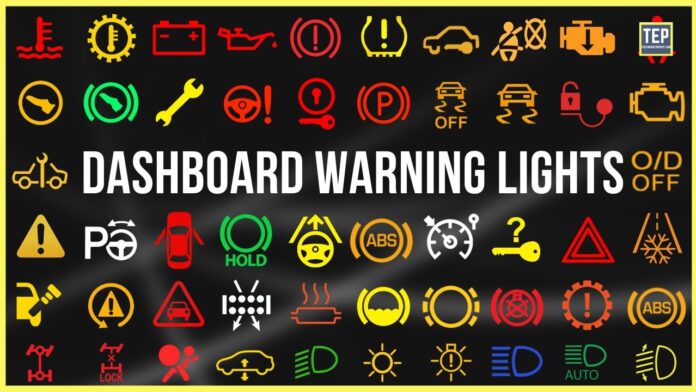Often times, as I am traveling using road transport, I notice a number of drivers stuck on the road because their cars had a mechanical issue while in transit. I do not rule out the possibility that some times it’s inevitable; however, some issues are shown to us on the car dash board, but we choose to ignore them.
Today we will be looking at some of the car warning signs and what they actually communicate.
The seat-belt warning light
An icon of a person wearing a seat-belt serves as the seat-belt warning light, which illuminates to remind the driver and passengers to buckle up. In most cases, the car tends to make irritating noises until one buckles up. This is important because seat-belts are a primary safety feature that helps protect the occupants in the event of a crash.
The fuel warning light, represented by an amber or red gas pump icon, appears when the fuel tank is near empty. The specific fuel level that triggers the light may vary by vehicle, but it typically indicates around one to two gallons of fuel remaining. The light may also turn on if the gas cap is not properly tightened.
The check engine light is a common dashboard warning light that indicates any engine-related issue. This can range from something as minor as a loose gas cap to more serious issues such as misfires, knocking, or loss of compression, which can lead to premature engine wear or failure. The check engine light can be red or amber.
The warning light, depicted as a red battery with plus and minus symbols, indicates that the vehicle’s charging system is not functioning properly. The issue could be the battery itself, but it could also be caused by a loose or corroded battery cable, a worn alternator, a broken accessory belt, or another electrical fault in the system. It’s normal for the light to turn on and then off when starting the vehicle, but if it turns on while driving, it’s important to pull over and stop as soon as it’s safe to do so.
The air suspension light is usually an indication that there is a problem with the air suspension system, such as a leak in the system, a faulty sensor, or an issue with the compressor. A yellow car with two arrows under it serves as its symbol. If you see the air suspension light on, it’s important to have it checked out by a professional to determine the cause and get it repaired.
The glow plug symbol indicates a malfunction ranging from a clogged fuel filter, damage to the fuel pump, brake lights, or turbocharger controller. A skilled technician should be able to diagnose the problem.
Brake Warning Lights, represented by a red circle with an exclamation point, indicate that there’s an issue with the braking system, or a routine notification that the parking brake is engaged. If you unexpectedly see this light pop up, it’s important to mechanical help. The cause of the light can range from something as simple as a sticky parking brake to low brake fluid or worn brake pads.
Traction Control Warning Light, represented by a car with two wavy lines underneath, works in conjunction with the anti-lock braking system (ABS) to improve vehicle stability and traction. It selectively applies the brakes to prevent the wheels from slipping during acceleration and often engages when driving on slippery surfaces such as gravel, wet ground and sand.
One may ask, what ABS is. The ABS Warning Light, represented by a yellow or red circle with the letters “ABS” in the center, pops up when a problem is detected with the anti-lock braking system or the system is actively being used. If it’s flashing while braking, the system is functioning as intended. However, if it’s on constantly, there’s a problem with the anti-lock braking system. ABS improves braking performance on slippery roads by pulsing the brakes to prevent the wheels from locking up and skidding.
Temperature Light. If a red thermometer on the engine temperature light shows up, it means the engine is overheating. This is a serious issue that can lead to significant engine damage. To prevent further damage, you should immediately pull over and turn off your vehicle.
The oil light, which is usually represented by a red oil can, indicates that the oil is not flowing properly through the engine. This is a critical problem, as low oil can lead to accelerated engine wear or even failure. Some common causes of low oil pressure include low oil levels, a worn oil pump, and other worn internal engine components.
Tire Pressure Warning Light, depicted as a yellow tire with an exclamation point in the middle, indicates that one of the vehicle’s tires is underinflated. In some modern vehicles, this light can also indicate which specific tire has low pressure. If it turns on while driving, you can find a nearby mechanic shop or fuel station for assistance.
When there is a problem with the steering system, the power steering warning light, which looks like a red or yellow steering wheel icon with an exclamation point on the side, illuminates. It is not safe to drive the vehicle if this light comes on because a lack of power steering assistance will make the car much harder to maneuver and can cause loss of control.
The airbag warning light indicates a problem with the vehicle’s airbag system, which is critical for the safety of the occupants in the event of a crash as it deploys the airbags and tightens the seat-belt to protect the passengers.
The open door light comes on when one of your doors isn’t closed all the way. Every time you start the engine, take a quick glance at the dash before you start moving to make sure this light isn’t on. It is represented by a red car with two doors open.
Full beam light, represented by a blue symbol, will illuminate on your car’s dashboard to make you aware of full beams so you can switch to dipped headlights when necessary.
There are a variety of car symbols depending on the car, but these are some of the common ones that will pop up on your dashboard to alert you.










